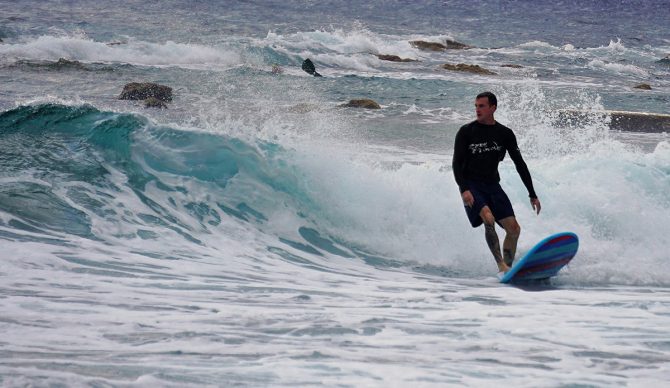
Photo: Daniel Bowen
The bridge lookout sweeps the horizon with his night-vision goggles. This part of the Caribbean is prime real estate for narcotics trafficking and there are indeed smugglers out here. Cocaine seems to be the primary drug of choice moving through this region of the world, smugglers often moving upwards of a thousand kilos per haul. And with a single kilo of pure uncut Colombian going upwards of 25 thousand American dollars, much is at stake in the everlasting game of drug-trafficking cat and mouse. The Coast Guard Cutter Vigilant is one of many pursuing vessels working in this region when not berthed in Cape Canaveral, Florida. Many of the Coasties that serve aboard call Cocoa Beach their land-side home, growing up here in the wake of Kelly Slater. They consider themselves true watermen and like most surfers have a passionate relationship with the ocean. But this is not a story about narcotics, this is a story of a port call where these sailors can resupply on fuel and other resources, and get some well-deserved rest and relaxation.
Naval Station Guantanamo Bay (GTMO) has rocky cliffs, dry deserts, cacti, and miles and miles of hot barren jaggedness. There is a McDonald’s, Subway, and a local hangout named O’Kelly’s claiming to be the only Irish pub on communist soil. For the sailors, soldiers, airmen, and marines unfortunate enough to be stationed in GTMO, there appears to be little else to do. But on further examination, underneath the barren, dry, scorched earth is a thriving water culture. Many of the residents participate in diving and spearfishing — their main target being lionfish, an invasive species that is threatening the ecosystem and coral reefs. There is also Windmills Beach, the most guarded surf break in the world, reserved for the few local inhabitants only, no outsiders, no exceptions.
Guantanamo Bay has been the center of controversy on multiple occasions in history. It is home to the infamous Camp X-ray, the detention center that used to house what the U.S. Government deemed the most dangerous terrorists and murderers in the world. These prisoners are now transferred to other GTMO facilities and include one of the masterminds behind the 9-11 attack on the World Trade Center. Also in their possession are those they deemed to be unlawful combatants. GTMO was at one time surrounded by over 55,000 landmines and considered the second-largest minefield in the world. Many of these hidden explosives have now been removed under the Obama Administration, however many are still there. If one of those pesky buggers doesn’t leave you minus a limb, there are remote sensors and guard towers surrounding the perimeter. At the very least, trespassers have numerous quills from the cacti protruding from their body reminiscent of an anti-blackhead pore strip. These are thanks to the local communists who planted them, encouraging Cuban deserters and refugees to stay clear of American soil.
Windmills Beach is named after the four 275-foot wind turbines towering on a nearby hill. The surf forecast will call for either decent waves or completely flat waters. With HOLD FAST tattooed across his knuckles, Lieutenant Tony Collins tries to describe the wave as he grips his log and surveys the scene while we prepare to get in the water.
“This wave at Windmills can be elusive and fickle,” he says. “Even 30 minutes can make the difference between getting the ultimate novelty wave or not. When it’s good, it’s crazy. A fast wedge that breaks into about six inches of water.”
At best, a clean three-to-four-foot session may be experienced during a dawn patrol when winds are heading offshore. The water is clean and the average temp is a warm 84 degrees. The shore is rocky and the surf is mostly reef break, certain areas going from 10-feet deep to two feet in a matter of seconds. For a few of the sailors coming in after weeks of patrolling at sea, it is a reprieve to get your stoke on and surf a wave, unlike all others.
“GTMO is an anomaly; even beyond its geography, terrain, and governmental weirdness, it’s the base that never should have been,” Collins explains. “The strangest thing about Windmills is its juxtaposition. There is literally a prison for terrorists on the cliff above you, and you are still very much on a military base… but when the wave there is breaking, you don’t feel like you are.”
We close the session on a thought: maybe we planted a seed in the minds of those watching. For those stationed up to two years in this veritable wasteland, finding something positive to do with any free time must be so liberating. If we were to show just one soldier or marine that this place can indeed be surfed, we’ve contributed something substantial to the place. Guarded by men with guns in camouflage, this break could turn one man’s prison into another soul’s sanctuary.

